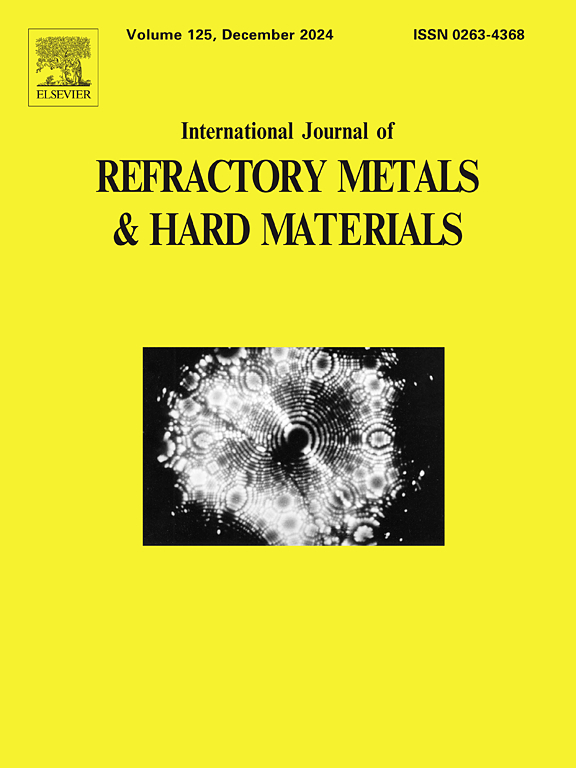结合剂相对WC基金刚石硬带基体性能和持合力的影响
IF 4.2
2区 材料科学
Q2 MATERIALS SCIENCE, MULTIDISCIPLINARY
International Journal of Refractory Metals & Hard Materials
Pub Date : 2025-04-09
DOI:10.1016/j.ijrmhm.2025.107184
引用次数: 0
摘要
金刚石增强WC基硬质合金的性能取决于基体的韧性、强度和金刚石抱持能力,因此在硬带方面具有很大的应用潜力。然而,在无压渗透过程中提高力学性能和控制微观结构的全面理论认识仍然有限。本研究采用无压渗法制备WC基硬质合金,系统研究了Ni和B含量变化对复合材料抗弯强度和显微组织特性的影响。结果表明,Cu-Zn-Mn渗渗WC基硬质合金的抗弯强度低于Cu-Mn-Ni。然而,当Ni添加量为4 wt%时,其抗弯强度(833.4 MPa)提高了10.3%,达到与Cu-Mn-Ni (861.3 MPa)相当的水平。将B以不同的比例添加到两种不同的金刚石复合材料配方中——60 wt%WC/40 wt%Cu-Mn-Ni和56 wt%WC/40 wt%Cu-Zn-Mn/4 wt% ni。Cu-Zn-Mn渗渗的金刚石复合材料在含B量为0.5 wt%时抗弯强度最大,达到714.2 MPa。同时,金刚石保持力系数达到85.7%,超过了Cu-Mn-Ni复合材料的82.9%。研究进一步发现,控制金刚石表面蚀刻和界面碳化硼形成是提高金刚石持持能力的主要因素。本文章由计算机程序翻译,如有差异,请以英文原文为准。

Role of binder phase on properties and holding ability of WC based diamond hardbanding matrix
Diamond reinforced WC based cemented carbide shows potential for hardbanding applications, with its performance hinging on the matrix's toughness, strength, and diamond holding ability. However, a comprehensive theoretical understanding of enhancing mechanical properties and controlling microstructure during pressureless infiltration remains limited. In this study, WC based cemented carbide was fabricated via pressureless infiltration, and the effects of Ni and B content variations on the bending strength and microstructural characteristics of the composites were systematically investigated. The results demonstrated that WC based cemented carbide with Cu-Zn-Mn infiltration exhibited lower bending strength compared to Cu-Mn-Ni. However, with the addition of 4 wt%Ni, its bending strength (833.4 MPa) increased by 10.3 %, reaching a level comparable to that of Cu-Mn-Ni (861.3 MPa). B was added to two distinct diamond composites formulations—60 wt%WC/40 wt%Cu-Mn-Ni and 56 wt%WC/40 wt%Cu-Zn-Mn/4 wt%Ni—with varying proportions. The diamond composites with Cu-Zn-Mn infiltration reached maximum bending strength at 0.5 wt%B content, achieving 714.2 MPa. At the same time, the diamond holding force coefficient reached 85.7 %, surpassing that of Cu-Mn-Ni composites (82.9 %). The study further identified that controlled diamond surface etching and interfacial boron carbide formation were the primary contributors to enhanced diamond holding ability.
求助全文
通过发布文献求助,成功后即可免费获取论文全文。
去求助
来源期刊
CiteScore
7.00
自引率
13.90%
发文量
236
审稿时长
35 days
期刊介绍:
The International Journal of Refractory Metals and Hard Materials (IJRMHM) publishes original research articles concerned with all aspects of refractory metals and hard materials. Refractory metals are defined as metals with melting points higher than 1800 °C. These are tungsten, molybdenum, chromium, tantalum, niobium, hafnium, and rhenium, as well as many compounds and alloys based thereupon. Hard materials that are included in the scope of this journal are defined as materials with hardness values higher than 1000 kg/mm2, primarily intended for applications as manufacturing tools or wear resistant components in mechanical systems. Thus they encompass carbides, nitrides and borides of metals, and related compounds. A special focus of this journal is put on the family of hardmetals, which is also known as cemented tungsten carbide, and cermets which are based on titanium carbide and carbonitrides with or without a metal binder. Ceramics and superhard materials including diamond and cubic boron nitride may also be accepted provided the subject material is presented as hard materials as defined above.

 求助内容:
求助内容: 应助结果提醒方式:
应助结果提醒方式:


